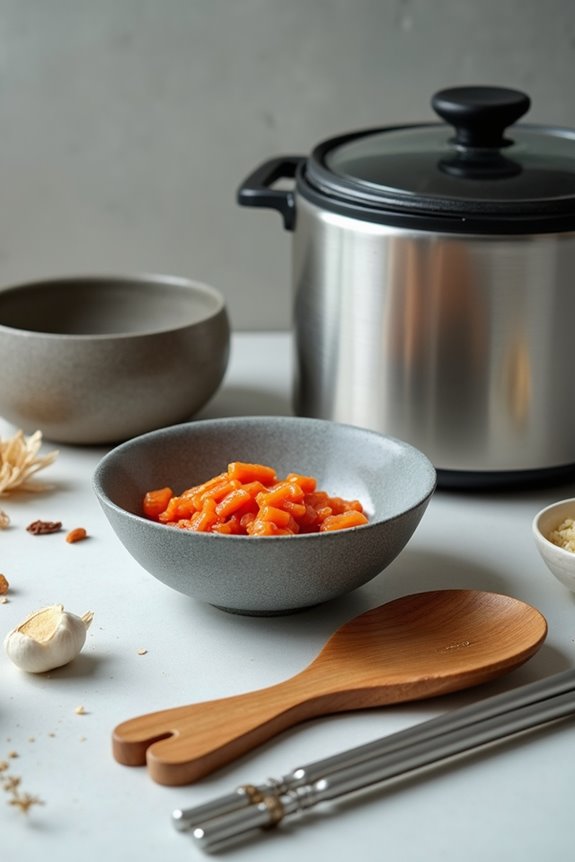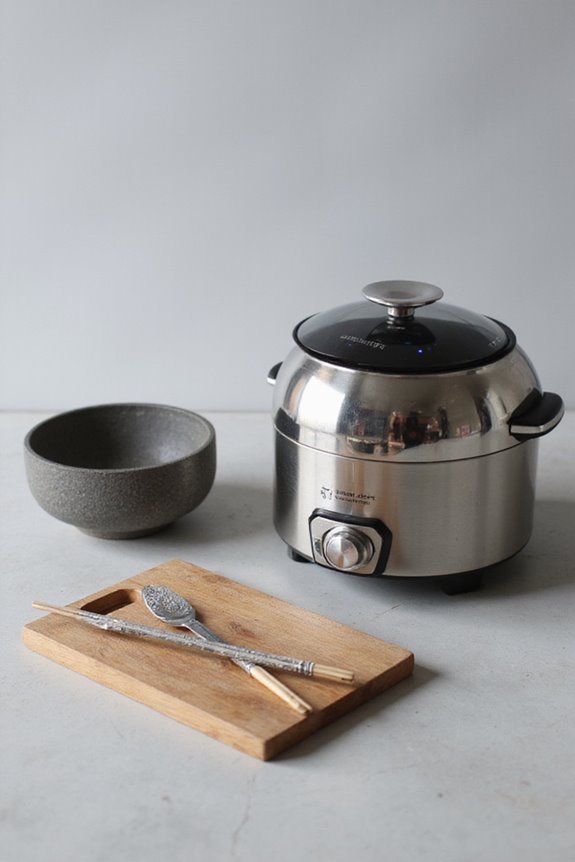When identifying quality Korean food equipment, we must consider compliance with the Food Sanitation Act and the specifications for materials used. Equipment made from durable, food-grade materials, like stainless steel, guarantees safety and reduces contamination risks. Proper hygiene practices in design allow for easy cleaning and thorough sterilization. Labels that comply with standards enhance consumer awareness of nutrition and source. Understanding these various factors will help us make informed choices in quality Korean food equipment.
Key Takeaways
- High-quality Korean food equipment adheres to strict MFDS regulations, ensuring safety and compliance with hazardous substance limits.
- Durable materials like stainless steel and food-grade plastics enhance hygiene and resist contamination during sterilization processes.
- Features such as smooth surfaces in equipment designs facilitate thorough cleaning, reducing microbial growth risks.
- Customizable cooking equipment, like modular BBQ grills, enhance the dining experience while maintaining quality standards.
- Innovative technologies, including smart automation and health-oriented designs, are essential indicators of quality in Korean food equipment.
Understanding the Food Sanitation Act Requirements
When we consider the Food Sanitation Act in Korea, we must understand its crucial role in regulating food equipment and related processes. This Act covers everything from manufacturing to the sale of food-related items, guaranteeing sanitation compliance throughout the food supply chain. It explicitly prohibits any products that contain hazardous materials, which could pose risks to consumers. The Ministry of Food and Drug Safety (MFDS) enforces these regulations, mandating that all food equipment must meet specific standards. By establishing testing methods for contaminants and restricting harmful substances, the MFDS enhances food safety. It’s essential for manufacturers and importers to stay updated with the Act’s requirements to guarantee compliance and contribute to public health and safety in the food industry.
Importance of Material Specifications in Food Equipment
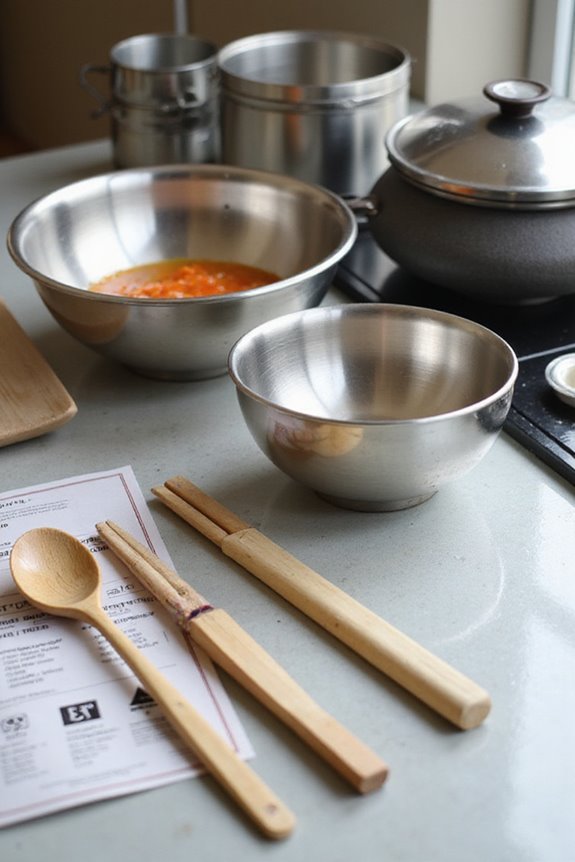
Understanding the importance of material specifications in food equipment is essential for ensuring safety and compliance within the industry. We need to recognize that material safety profoundly impacts both health and regulation adherence. For instance, South Korea strictly limits hazardous substances in food contact materials, particularly ensuring lead content is below 0.1%. Compliance with MFDS equipment specifications is mandatory for manufacturers and importers, requiring documentation that demonstrates the absence of toxic elements. Additionally, food contact equipment must endure sterilization without compromising structural integrity. Choosing materials like stainless steel and food-grade plastics promotes durability, reducing the risk of contamination. Ultimately, adherence to stringent material specifications not only safeguards public health but also fosters trust in the food supply chain, benefiting everyone involved. Furthermore, selecting durable nonstick coatings can enhance food release and simplify cleanup, thereby promoting a healthier cooking environment.
Labeling Standards for Imported Food Products
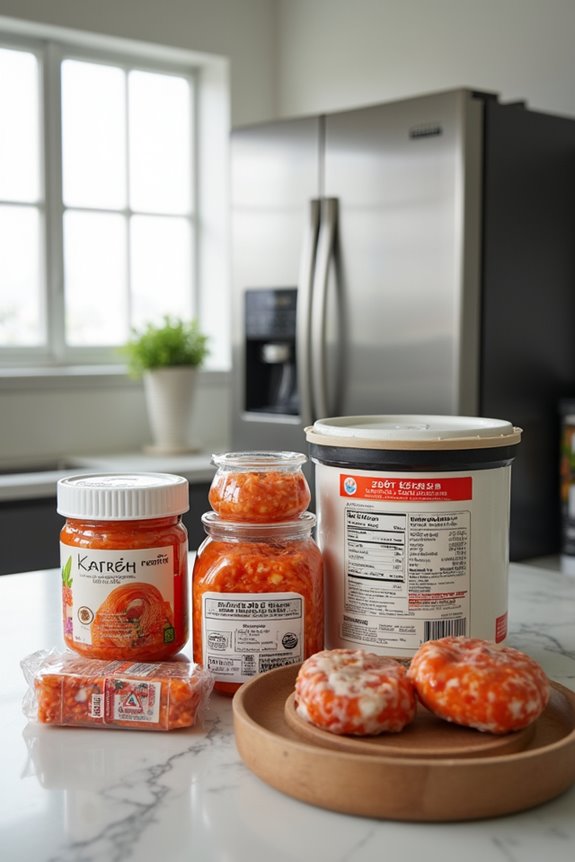
Labeling standards for imported food products in South Korea are set to guarantee that all items are clearly marked for consumers, reflecting both safety and regulatory compliance. Import labeling must include the product name in Korean, matching what’s declared to authorities. Nutritional requirements entail detailed calorie counts, macronutrients, and other crucial information. For example, sugary foods now need proper nutrition labels due to recent amendments. Manufacturers must also include details about the product’s origin, along with the importer’s contact information. Labels should be legible with appropriate font sizes and colors to maintain clarity. By enforcing these standards, South Korea aims to enhance food safety and consumer awareness across its market, providing essential information while promoting responsible consumption.
Hygiene Practices in Food Processing Equipment

Hygiene practices in food processing equipment are critical for guaranteeing the safety and quality of food products. We must prioritize hygienic design, which facilitates easy and thorough cleaning, minimizing contamination risks. Equipment should feature smooth surfaces free from pits and crevices, preventing microbial accumulation. By adhering to established cleaning protocols, we can effectively remove biological, chemical, and physical hazards. Regular cleaning must align with the type of food processed and its associated contamination risks. For example, machinery involved in making ice candy requires precise sterilization, highlighting the importance of stringent hygiene measures. Complying with regulations from the Ministry of Food and Drug Safety ensures that our equipment meets stringent safety standards, ultimately protecting the food we produce and consume.
Key Regulatory Agencies in Food Equipment Safety
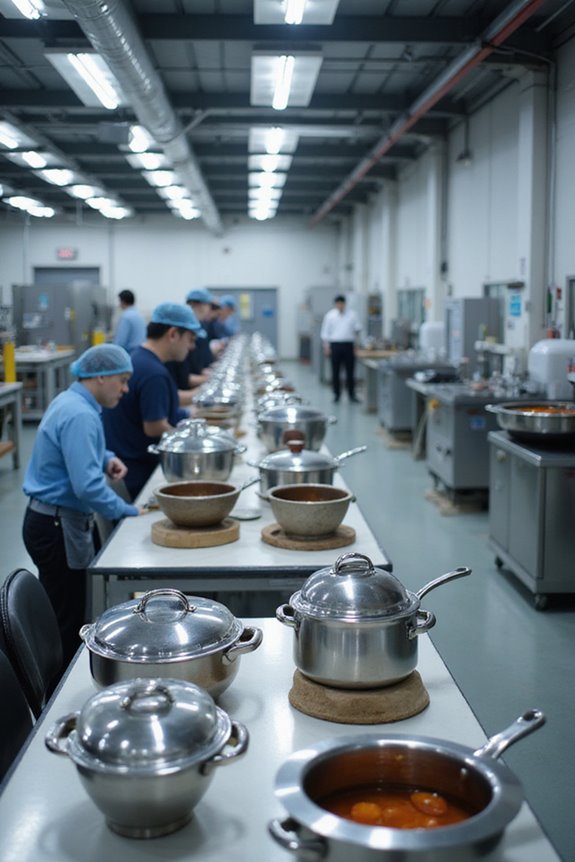
Regulatory agencies play a crucial role in ensuring food equipment safety, as they establish standards and enforce compliance throughout the food supply chain. In South Korea, the Ministry of Food and Drug Safety (MFDS) primarily oversees food safety, including equipment certification. They enforce the Food Code, ensuring all equipment meets safety standards. The Ministry of Agriculture, Food and Rural Affairs (MAFRA) focuses on agricultural production and collaborates with MFDS on safety regulations. Additionally, the Ministry of Trade, Industry and Energy (MOTIE) governs industrial equipment standards, emphasizing energy efficiency. Finally, the Korean Agency of HACCP Accreditation and Services (KAHAS) provides training and consultation, ensuring regulatory compliance with HACCP standards. Together, these agencies create a robust framework for food equipment safety.
Quality Indicators for Food Equipment Compliance
When evaluating food equipment compliance, we must consider several quality indicators that safeguard safety and effectiveness throughout the food supply chain. First, we focus on material safety and compliance with non-toxic standards, guaranteeing equipment meets both local and international regulations, which prevent harmful chemical releases. Next, durable design and manufacturing standards are significant, requiring materials to withstand cleaning processes, maintaining hygiene. The operational reliability of components is a fundamental compliance benchmark, preventing contamination while in use. Finally, traceability and quality assurance mechanisms are indispensable in a robust quality assessment framework, confirming documentation verifies compliance and supports recall processes when necessary. By adhering to these indicators, we can guarantee both food safety and equipment quality.
The Role of Proper Labeling in Food Safety
Proper labeling plays an essential role in ensuring food safety, as it communicates important information about a product’s content and handling requirements to consumers. We must prioritize label clarity to enhance consumer awareness, helping individuals make informed choices for their health. Regulatory bodies like the FDA and USDA enforce guidelines that dictate labeling requirements, ensuring that perishable items are marked with instructions such as “Keep Refrigerated.” This clarity is vital, especially for foods with potential allergens or hazards. Furthermore, accurate nutrition labeling allows consumers to assess their dietary needs effectively. Manufacturers bear the responsibility of using safe materials for labels. Consequently, thorough labeling practices ultimately safeguard public health and foster better food choices in today’s market.
Evaluating Durability and Safety in Food Equipment
In evaluating durability and safety in food equipment, we must consider the vital role of material quality and design features that influence performance across various applications. A thorough durability assessment is imperative, as Korean standards require food equipment to withstand high temperatures and repeated sterilization without compromising safety. This guarantees that harmful substances are not released during use. Effective safety features are essential; equipment must feature smooth, non-porous surfaces that minimize contamination risks and are easy to clean. For example, the use of stainless steel and FDA-approved plastics enhances resistance to microbial colonization. Additionally, rigorous sanitation validation procedures enhance the equipment’s reliability, confirming compliance with strict materials safety standards set by the Ministry of Food and Drug Safety.
Trends in Food Equipment Quality Improvement
As we assess the evolving landscape of food equipment quality, it’s clear that several significant trends are shaping the industry. Customization trends are prominent, with equipment supporting personalized dining experiences, such as modular Korean BBQ grills that accommodate diverse cooking styles. Sustainability practices are also essential, as manufacturers develop eco-friendly materials and energy-efficient appliances, addressing consumer demand for more sustainable options. Additionally, automation innovations, like smart grills and AI-driven self-serve systems, enhance efficiency while reducing labor costs. Finally, health technologies play a key role, focusing on non-stick surfaces and steam cooking methods that promote healthier meal preparation. Together, these trends reflect a commitment to quality improvements in Korean food equipment, benefiting both operators and consumers.
Frequently Asked Questions
What Are the Consequences of Using Non-Compliant Food Equipment?
Using non-compliant food equipment exposes us to serious non-compliance risks, leading to health hazards. It can result in fines, legal troubles, and damage to our reputation, ultimately threatening our business’s stability and consumer trust.
How Do Inspections Ensure Food Equipment Safety?
Inspections guarantee food equipment safety by enforcing stringent inspection processes and adherence to equipment standards. Together, we can appreciate how these measures protect consumer health and maintain high safety levels in our food supply chain.
Can Homemade Food Equipment Meet Quality Standards?
We can’t ignore homemade equipment quality; it often struggles to meet safety standards. While crafting at home adds charm, the lack of certification can lead to potential risks and inconsistencies in food safety we should consider seriously.
What Is the Food-Related Mark’s Significance for Consumers?
Like a shield protecting our meals, the food-related mark assures us of food safety. It boosts consumer awareness, helping us choose safe equipment and ensuring our kitchens aren’t just functional but safe for our loved ones.
Are There Penalties for Improper Food Equipment Labeling?
Yes, there’re definitely penalties for improper food equipment labeling. We must adhere to labeling regulations; non-compliance leads to compliance penalties like fines or recalls, emphasizing the importance of accurate and clear information for consumer safety.



